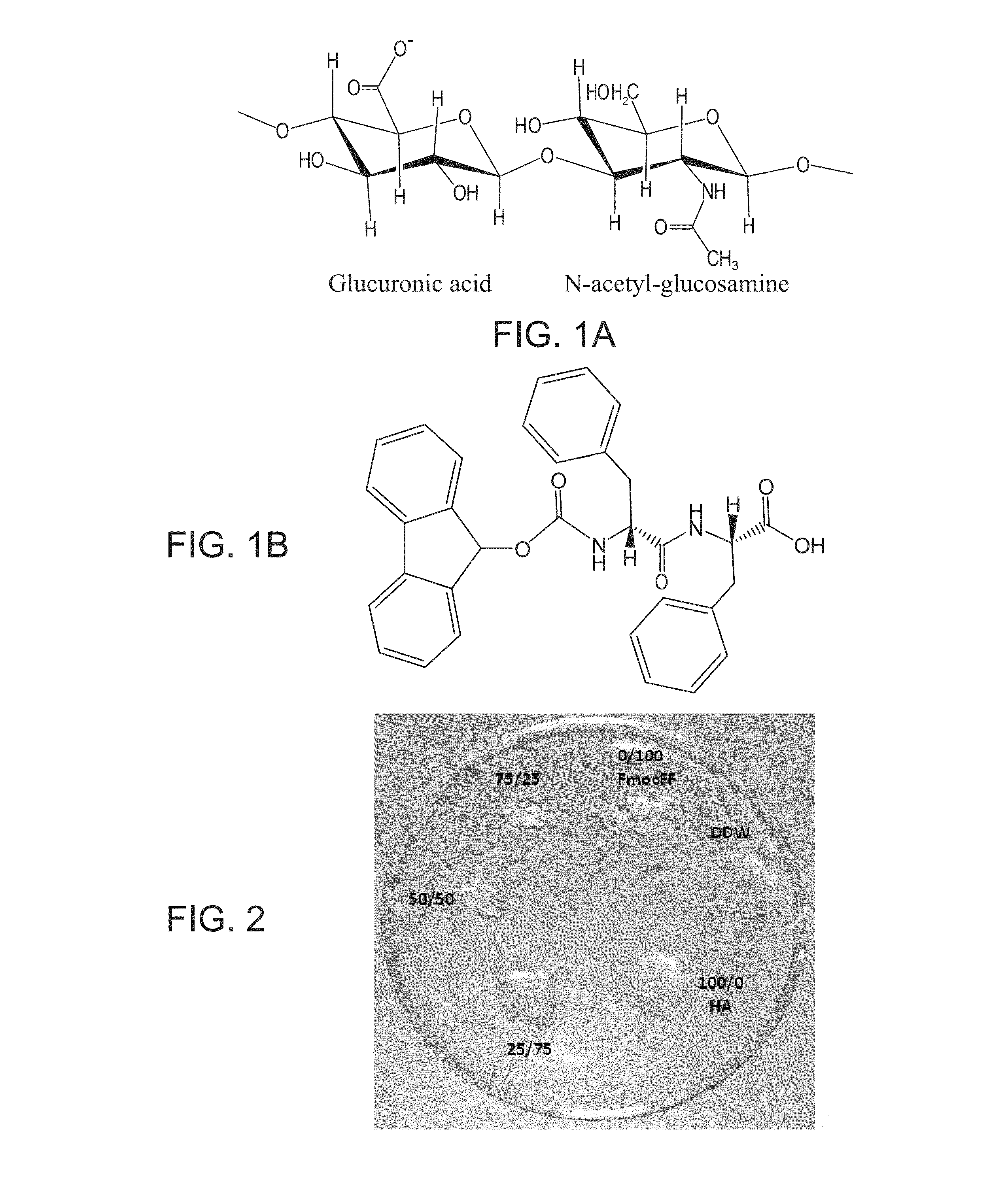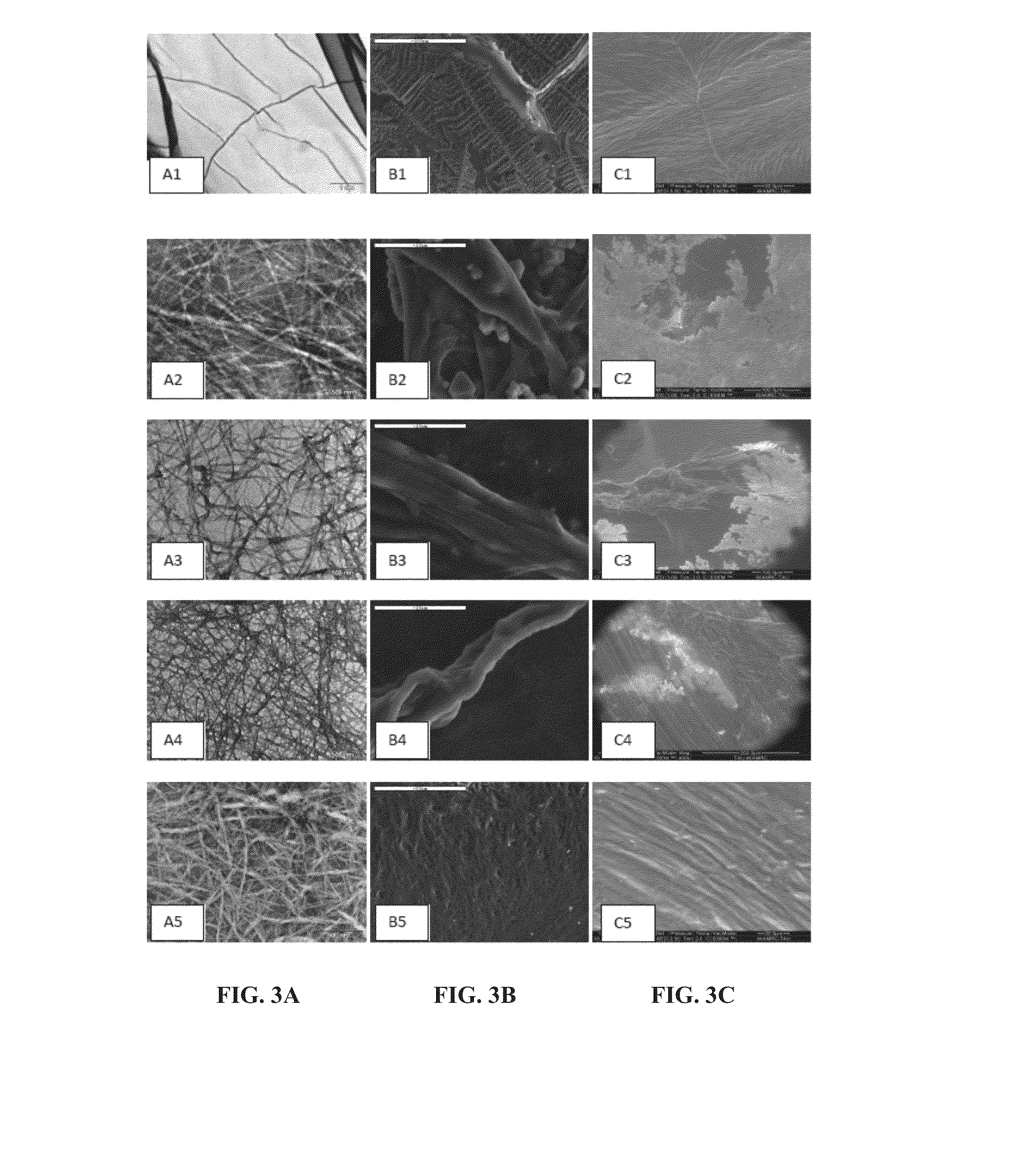Malleable hydrogel hybrids made of self-assembled peptides and biocompatible polymers and uses thereof
a hybrid hydrogel and self-assembled technology, applied in the field of biomaterials, can solve the problems of poor mechanical strength, limited use of ha, and low biocompatibility of products
- Summary
- Abstract
- Description
- Claims
- Application Information
AI Technical Summary
Benefits of technology
Problems solved by technology
Method used
Image
Examples
example 1
Hybrid Hydrogel Formation and Characterization
Materials and Experimental Methods
[0413]Materials:
[0414]Lyophilized Fmoc-diphenylalanine peptide was purchased from Bachem (Budendorf, Switzerland).
[0415]High molecular weight (3×106) hyaluronic acid as a sodium salt was obtained from BTG-Ferring (Kyriat Malahy, Israel) in syringes as a solution of 1% HA in PBS.
[0416]Formation of Hybrid Fmoc-FF / HA Hydrogels:
[0417]In a typical procedure, lyophilized Fmoc-FF peptide was dissolved in DMSO (Dimethyl sulfoxide) to achieve a concentration of 0.1 mg / ml. The peptide stock solution was diluted by adding HA (1%) solubilized in ddH2O (DDW), to achieve a final concentration 0.5% w / w (5 mg / ml) of the combined substances. The mixture was physically blended by vortex and then maintained at room temperature until gellation is complete, unless otherwise indicated.
[0418]Different hybrid hydrogels were prepared by using different peptide-HA ratios. Thus, a 25 / 75 w / w hydrogel was composed of 1.25 mg Fmoc-FF...
example 2
Degradation of Hybrid Gels
[0475]Hydrogels' biodegradation was examined in the presence of hyaluronidase, an enzyme that degrades hyaluronic acid. The hybrid hydrogels described herein are designed so as to result in a slower degradation rate and longer retention time in the body, compared to that of HA, yet without using chemical cross-linking.
[0476]Assay Protocol:
[0477]The in vitro enzymatic degradations of the hydrogels were measured as a function of time by incubating the gels in the presence of hyaluronidase (Hyase), by monitoring the residual mass of the hydrogel; and by determining the released glucuronic acid from the hydrogel to the solution by a Dische assay, as described in [Z. Dische 1947 J. Biol. Chem. 167: 189-198]. In brief, 0.2 ml of 0.1% carbazole solution in alcohol was added to 1 ml of a tested sample. After vortexing, 6 ml of concentrated H2SO4 was added to the solution. The glass tubes were closed with coupled sleeves, boiled for 15 minutes in a water bath, and t...
example 3
Biocompatability Assays
[0486]Cells Viability Test:
[0487]To verify the ability of the hybrid hydrogels described herein to be used in biological applications, their biocompatibility was determined using an in vitro cell culture experiment. Three types of cells were cultivated on top of the hybrid hydrogels: CHO (Chinese Hamster Ovaries), fibroblasts and chondrocytes.
[0488]Assay Protocol:
[0489]CHO, fibroblasts and chondrocytes cells were grown in Dulbecco's Modified Eagle Medium (DMEM) supplemented with 10% fetal calf serum, 100 U / ml penicillin, 100 U / ml streptomycin, and 2 mmol / liter L-glutamine (all from Beit Haemeck, Israel). Cells were maintained at 37° C. in a humidified atmosphere containing 5% CO2. Subconfluent cultures were harvested by trypsinization, counted, and diluted in specific cells' media to form a cell concentration of 106 cells / ml. The gels swelled overnight with 0.1 ml DMEM. The next day, DMEM was removed and 0.1 μl of the CHO cells (105 cells) were placed on top o...
PUM
| Property | Measurement | Unit |
|---|---|---|
| frequency | aaaaa | aaaaa |
| storage modulus | aaaaa | aaaaa |
| average diameter | aaaaa | aaaaa |
Abstract
Description
Claims
Application Information
 Login to View More
Login to View More - R&D
- Intellectual Property
- Life Sciences
- Materials
- Tech Scout
- Unparalleled Data Quality
- Higher Quality Content
- 60% Fewer Hallucinations
Browse by: Latest US Patents, China's latest patents, Technical Efficacy Thesaurus, Application Domain, Technology Topic, Popular Technical Reports.
© 2025 PatSnap. All rights reserved.Legal|Privacy policy|Modern Slavery Act Transparency Statement|Sitemap|About US| Contact US: help@patsnap.com



